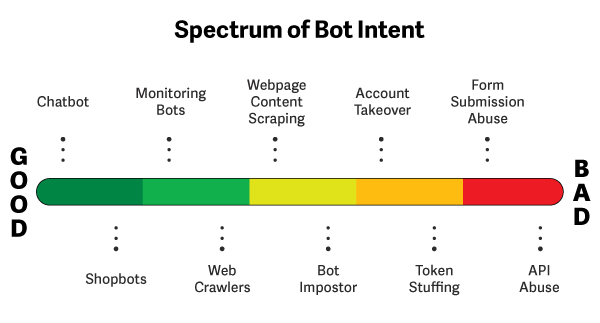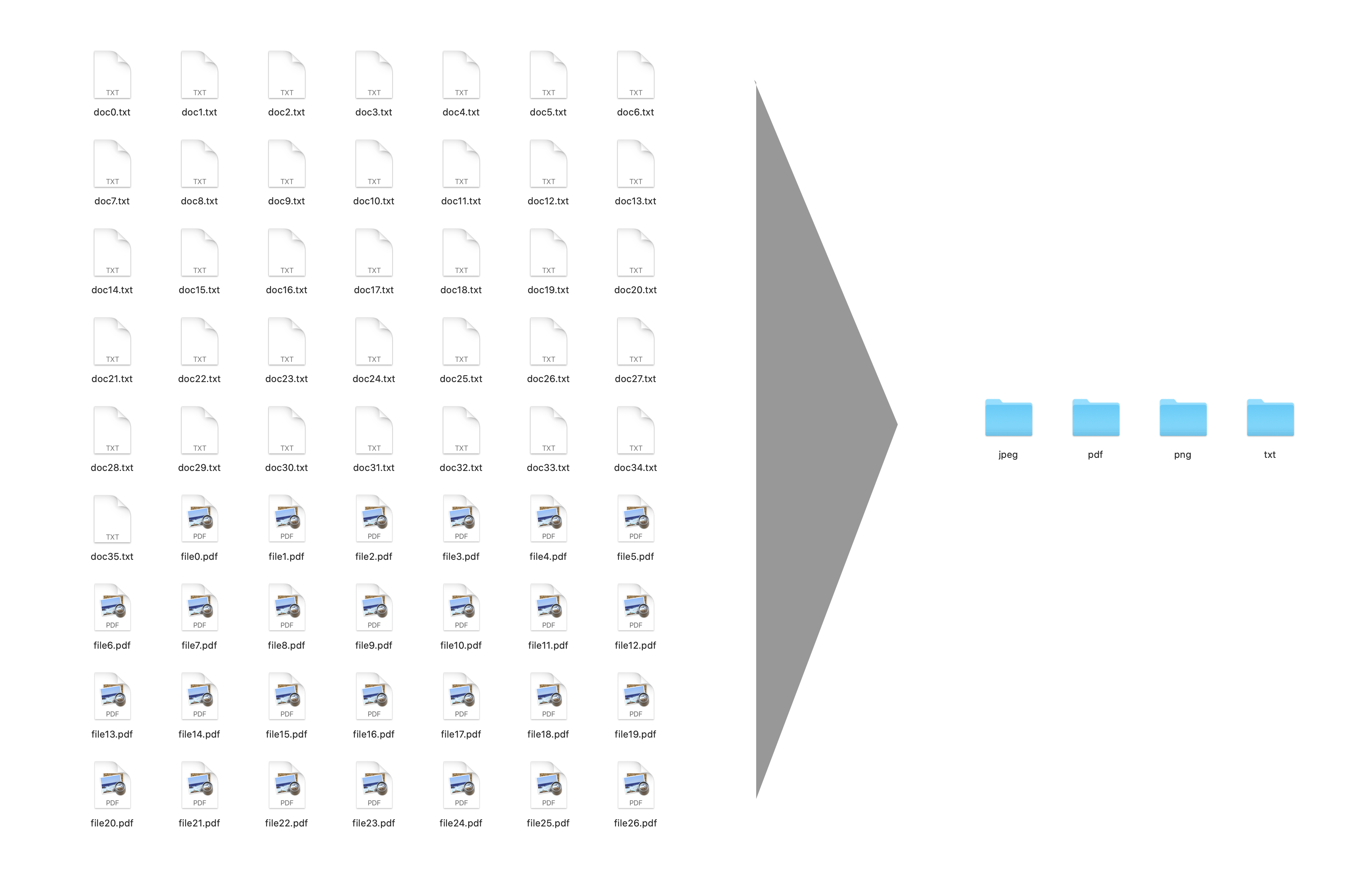Your File Is Broken We Will Delete It and Try Again Instabot

Most jobs have repetitive tasks that you can automate, which frees upwardly some of your valuable time. This makes automation a fundamental skill to acquire.
A small grouping of skilled automation engineers and domain experts may be able to automate many of the most tiresome tasks of entire teams.
In this commodity, nosotros'll explore the nuts of workflow automation using Python – a powerful and easy to learn programming language. We will apply Python to write an like shooting fish in a barrel and helpful piddling automation script that will make clean upwardly a given binder and put each file into its according folder.
Our goal won't exist to write perfect lawmaking or create ideal architectures in the commencement.
We also won't build annihilation "illegal". Instead we'll look at how to create a script that automatically cleans upwardly a given folder and all of its files.
Tabular array of contents
- Areas of Automation and Where to Start
- Simple Automation
- Public API Automation
- API Reverse Engineering
- Ethical Considerations of Automation
- Creating a Directory Clean-Up Script
- A Complete Guide to Bot Creation and Automating Your Everyday Work
Areas of Automation and Where to Start
Let'due south start with defining what kind of automations at that place are.
The art of automation applies to most sectors. For starters, it helps with tasks like extracting email addresses from a bunch of documents so you can practice an email boom. Or more complex approaches like optimizing workflows and processes inside of large corporations.
Of course, going from small personal scripts to big automation infrastructure that replaces actual people involves a process of learning and improving. So permit's see where yous can start your journeying.
Simple Automations
Elementary automations allow for a quick and straightforward entry point. This can cover small independent processes like projection clean-ups and re-structuring of files inside of directories, or parts of a workflow like automatically resizing already saved files.
Public API Automations
Public API automations are the well-nigh common form of automation since we can access most functionality using HTTP requests to APIs nowadays. For instance, if you lot want to automate the watering of your self-made smart garden at home.
To practice that, you want to bank check the atmospheric condition of the current mean solar day to run across whether you demand to h2o or if there is rain incoming.
API Reverse Engineering science
API opposite engineering-based automation is more than mutual in actual bots and the "Bot Imposter" section of the chart in the "Upstanding Considerations" section below.
By reverse-engineering an API, we understand the user flow of applications. One example could be the login into an online browser game.
By understanding the login and hallmark process, we can duplicate that behaviour with our own script. Then we can create our own interface to work with the application even though they don't provide it themselves.
Whatever approach you're aiming at, always consider whether it's legal or non.
You lot don't want to get yourself into trouble, exercise y'all? ?
Ethical Considerations
Some guy on GitHub once contacted me and told me this:
"Likes and engagement are digital currency and yous are devaluing them."
This stuck with me and made me question the tool I've built for exactly that purpose.
The fact that these interactions and the appointment can be automated and "faked" more and more leads to a distorted and cleaved social media system.
People who produce valuable and good content are invisible to other users and advert companies if they don't employ bots and other engagement systems.
A friend of mine came upward with the following clan with Dante's "Nine Circles of Hell" where with each step closer to becoming a social influencer you get less and less aware of how broken this whole system actually is.
I want to share this with y'all here since I call up it'southward an extremely authentic representation of what I witnessed while actively working with Influencers with InstaPy.
Level 1: Limbo - If you don't bot at all
Level 2: Flirtation - When you manually like and follow every bit many people every bit yous can to get them to follow you back / similar your posts
Level 3: Conspiracy - when yous join a Telegram group to like and comment on ten photos and then the adjacent x people will similar and comment on your photograph
Level four: Infidelity - When you use a low-price Virtual Assistant to like and follow on your behalf
Level 5: Lust - When you use a bot to give likes, and don't receive whatsoever likes back in return (but you don't pay for it - for example, a Chrome extension)
Level 6: Promiscuity - When you use a bot to Requite l+ likes to Get l+ likes, merely you don't pay for it - for example, a Chrome extension
Level 7: Avarice or Extreme Greed - When yous use a bot to Like / Follow / Comment on between 200–700 photos, ignoring the hazard of getting banned
Level 8: Prostitution - When y'all pay an unknown 3rd political party service to appoint in automated reciprocal likes / follows for you lot, simply they employ your account to similar / follow back
Level nine: Fraud / Heresy - When y'all buy followers and likes and endeavor to sell yourself to brands as an influencer
The level of botting on social media is and so prevalent that if you don't bot, you will be stuck in Level 1, Limbo, with no follower growth and depression date relative to your peers.
In economic theory, this is known as a prisoner'southward dilemma and zero-sum game. If I don't bot and you bot, y'all win. If yous don't bot and I bot, I win. If no one bots, everyone wins. Only since there is no incentive for anybody not to bot, everyone bots, and so no one wins.
Be aware of this and never forget the implications this whole tooling has on social media.

Nosotros want to avoid dealing with upstanding implications and still work on an automation project hither. This is why we volition create a unproblematic directory clean-up script that helps you organise your messy folders.
Creating a Directory Clean-Up Script
Nosotros now want to wait at a quite uncomplicated script. It automatically cleans upwardly a given directory by moving those files into co-ordinate folders based on the file extension.
So all we want to practise is this:

Setting up the Argument Parser
Since we are working with operating system functionality like moving files, we need to import the bone library. In addition to that, we want to give the user some control over what binder is cleaned up. Nosotros will use the argparse library for this.
import os import argparse After importing the two libraries, let'due south first fix the argument parser. Make sure to give a clarification and a assist text to each added argument to give valuable assistance to the user when they type --aid.
Our argument will be named --path. The double dashes in front of the proper noun tell the library that this is an optional argument. By default we want to utilise the current directory, so set the default value to be ".".
parser = argparse.ArgumentParser( description="Make clean upward directory and put files into according folders." ) parser.add_argument( "--path", type=str, default=".", aid="Directory path of the to be cleaned directory", ) # parse the arguments given past the user and excerpt the path args = parser.parse_args() path = args.path impress(f"Cleaning up directory {path}") This already finishes the argument parsing section – it'due south quite elementary and readable, right?
Let'due south execute our script and cheque for errors.
python directory_clean.py --path ./test => Cleaning upwards directory ./examination One time executed, we can see the directory proper name beingness printed to the panel, perfect.
Let's now utilize the os library to get the files of the given path.
Getting a list of files from the folder
By using the os.listdir(path) method and providing information technology a valid path, we become a list of all the files and folders inside of that directory.
After listing all elements in the folder, we want to differentiate between files and folders since we don't want to make clean up the folders, only the files.
In this case, we use a Python list comprehension to iterate through all the elements and put them into the new lists if they meet the given requirement of beingness a file or binder.
# go all files from given directory dir_content = bone.listdir(path) # create a relative path from the path to the file and the document name path_dir_content = [os.path.join(path, doctor) for dr. in dir_content] # filter our directory content into a documents and folders listing docs = [md for doc in path_dir_content if os.path.isfile(doc)] folders = [folder for folder in path_dir_content if bone.path.isdir(folder)] # counter to keep track of corporeality of moved files # and list of already created folders to avoid multiple creations moved = 0 created_folders = [] print(f"Cleaning up {len(docs)} of {len(dir_content)} elements.") Equally always, let's make sure that our users get feedback. Then add together a print statement that gives the user an indication well-nigh how many files will be moved.
python directory_clean.py --path ./test => Cleaning up directory ./test => Cleaning upwards 60 of 60 elements. Afterwards re-executing the python script, we can now see that the /test folder I created contains lx files that will be moved.
Creating a folder for every file extension
The next and more than important step now is to create the binder for each of the file extensions. We want to practice this by going through all of our filtered files and if they have an extension for which there is no folder already, create one.
The os library helps us with more than overnice functionality similar the splitting of the filetype and path of a given document, extracting the path itself and name of the document.
# go through all files and move them into according folders for doc in docs: # separte name from file extension full_doc_path, filetype = bone.path.splitext(doc) doc_path = os.path.dirname(full_doc_path) doc_name = os.path.basename(full_doc_path) print(filetype) print(full_doc_path) impress(doc_path) impress(doc_name) break The suspension argument at the terminate of the code above makes sure that our terminal does non go spammed if our directory contains dozens of files.
In one case nosotros've set this up, let'south execute our script to meet an output like to this:
python directory_clean.py --path ./test => ... => .pdf => ./test/test17 => ./test => test17 We tin can now run into that the implementation to a higher place splits off the filetype and and so extracts the parts from the full path.
Since we take the filetype now, nosotros can check if a folder with the name of this type already exists.
Before nosotros practise that, nosotros want to brand sure to skip a few files. If we use the electric current directory "." as the path, we need to avert moving the python script itself. A unproblematic if condition takes care of that.
In addition to that, nosotros don't want to move Hidden Files, so let'south too include all files that start with a dot. The .DS_Store file on macOS is an case of a hidden file.
# skip this file when it is in the directory if doc_name == "directory_clean" or doc_name.startswith('.'): continue # become the subfolder name and create folder if not exist subfolder_path = os.path.join(path, filetype[1:].lower()) if subfolder_path not in folders: # create the binder Once we've taken care of the python script and hidden files, we can at present move on to creating the folders on the organization.
In addition to our check, if the folder already was at that place when nosotros read the content of the directory, in the beginning, we need a way to track the folders we've already created. That was the reason we declared the created_folders = [] listing. It will serve equally the retentiveness to track the names of folders.
To create a new folder, the os library provides a method called bone.mkdir(folder_path) that takes a path and creates a folder with the given name at that place.
This method may throw an exception, telling us that the folder already exists. And so let'due south also make sure to take hold of that error.
if subfolder_path not in folders and subfolder_path not in created_folders: attempt: os.mkdir(subfolder_path) created_folders.append(subfolder_path) impress(f"Folder {subfolder_path} created.") except FileExistsError as err: print(f"Folder already exists at {subfolder_path}... {err}") After setting up the folder creation, permit's re-execute our script.
python directory_clean.py --path ./test => ... => Folder ./test/pdf created. On the first run of execution, we can see a list of logs telling us that the folders with the given types of file extensions take been created.
Moving each file into the correct subfolder
The concluding step at present is to really move the files into their new parent folders.
An important matter to understand when working with os operations is that sometimes operations tin not be undone. This is, for case, the instance with deletion. And then it makes sense to outset only log out the behavior our script would achieve if we execute it.
This is why the os.rename(...) method has been commented here.
# get the new folder path and movement the file new_doc_path = os.path.join(subfolder_path, doc_name) + filetype # os.rename(doc, new_doc_path) moved += ane print(f"Moved file {md} to {new_doc_path}") After executing our script and seeing the correct logging, nosotros can now remove the comment hash before our os.rename() method and give it a final go.
# get the new folder path and move the file new_doc_path = bone.path.join(subfolder_path, doc_name) + filetype os.rename(doc, new_doc_path) moved += one print(f"Moved file {physician} to {new_doc_path}") print(f"Renamed {moved} of {len(docs)} files.") python directory_clean.py --path ./examination => ... => Moved file ./test/test17.pdf to ./examination/pdf/test17.pdf => ... => Renamed sixty of 60 files. This final execution will now move all the files into their appropriate folders and our directory volition exist nicely cleaned up without the need for transmission actions.
In the adjacent step, we could now use the script nosotros created above and, for example, schedule it to execute every Monday to clean up our Downloads folder for more structure.
That is exactly what we are creating equally a follow-up inside of our Bot Cosmos and Workflow Automation Udemy class.
A Complete Guide to Bot Cosmos and Automating Your Everyday Work
Felix and I built an online video course to teach you how to create your own bots based on what we've learned building InstaPy and his Travian-Bot. In fact, he was fifty-fifty forced to take downwards since information technology was besides constructive.
Bring together right in and outset learning.
If you have any questions or feedback, feel free to reach out to us on Twitter or directly in the discussion section of the grade ?
Learn to code for free. freeCodeCamp's open source curriculum has helped more than than 40,000 people get jobs as developers. Get started
teichelmannsiled1978.blogspot.com
Source: https://www.freecodecamp.org/news/building-bots/